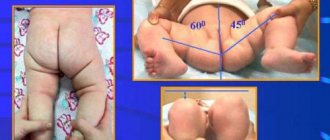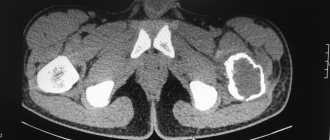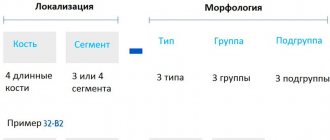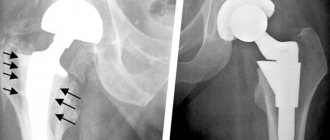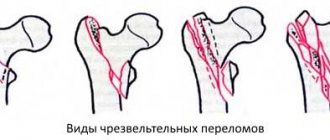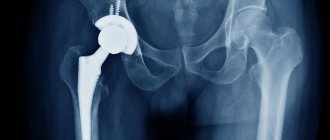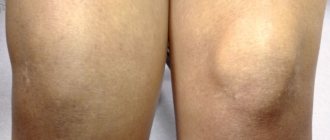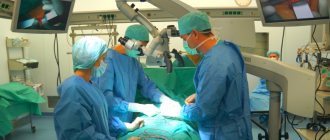In medicine, a dislocation of the hip joint is a displacement of the head of the femur, accompanied by damage to the joint capsule. In adults, the cause of pathology is injury, in children – hip dysplasia.
Do not confuse a dislocation with a subluxation of the hip joint. With the latter, the head of the femur is incorrectly oriented in space, but does not extend beyond the acetabulum.
Causes of hip dislocation in adults
In adults, dislocations of the hip joint are rare. This is explained by the fact that the head of the femur is firmly fixed in the acetabulum, and the joint itself is strengthened by ligaments and muscles. In order for the femur to move from its place, a high-velocity traumatic factor is needed.
Possible reasons for the displacement:
- car crashes;
- natural disasters;
- landslides;
- falling from a height;
- disasters.
Dislocation occurs due to the indirect action of an external force placed directly on the femur . The latter acts as a lever. The impact of a traumatic factor on the hip joint itself usually leads to fractures of the femoral neck or pelvic bones.
In some cases, dislocation may be accompanied by pinching of the obturator nerves, compression of the femoral vessels, contusion of the sciatic nerve and fractures of the bones that form the acetabulum. If not treated in a timely manner, these complications can lead to the death of the soft tissues of the limb or even complete paralysis of the leg.
Fracture of the right (left) acetabulum on x-ray.
Hip joint dislocations usually occur in men and women under 50 years of age. Elderly people suffer from osteoporosis. The disease makes bones very fragile, making them easy to break. Therefore, at older ages, fractures of the femoral neck occur much more often.
Table 1. Classification of dislocations
| View | Description | Development mechanism |
| Suprapubular | The femoral head is located anterior to the ilium. The patient's leg is extended and turned outward. A convex formation is visible in the groin area, and the buttock on the side of the injured limb looks flattened | A sharp fall from a height onto an abducted, bent and turned outward leg |
| Obturator | The head of the femur is located next to the pubis. The lower limb is strongly turned outward, bent at the knee and hip joints | Similar to previous |
| Iliac | The femur is located behind the ilium. The leg is bent and turned inward. There is a protrusion in the buttock area, and a recess in the groin. On examination, shortening of the leg is noticeable. | Sudden bending or rotation of the leg at the knee and hip joint, which usually occurs in an accident |
| Sciatic | The head of the femur is located near the ischium. The deformity is more pronounced than with iliac dislocation | Similar to previous |
Consequences of instability
Prosthesis displacement
As a result of this phenomenon, the implanted implant not only loses its fixation and becomes loose, but also leads to a gradual or sudden change in the length of the legs. In this case, immediate consultation with a doctor and repeated surgery on the limb are required. The main reasons include the following:
- incorrect installation of the implant;
- insufficient contact between the surfaces of the joint and the prosthesis;
- heavy loads on the implant;
- weak connection of product components.
Dislocation - dislocation.
Osteolysis
The formation of this process can result from partial or complete destruction of the bone, which occurs as a result of the interaction of the components of the prosthesis with living tissue.
Endoprosthesis fracture
Diagnosis of prosthetic fractures, which periodically occur, suggests the following reasons for such consequences. These include:
- incorrect selection of an individual implant;
- excessive or premature high physical activity of the patient;
- overweight patient.
To prevent the onset of such consequences, you must strictly follow the recommendations given by your doctor and not engage in excessive physical activity.
Special cases include loosening and damage to individual components of the prosthesis. In a fairly short period of time, the structure of the polyethylene liner or femoral stem may collapse. Dislocation or fracture of the endoprosthesis also occurs quite often. Therefore, it is imperative to follow the recommendations of specialists, as well as carry out diagnostic and preventive measures. This is guaranteed to help prevent the occurrence of negative consequences of the operation.
Formation of blood clots
Such clots form in the vessels of the lower extremities. This complication does not require repeated surgery. It is enough to complete a therapeutic course prescribed by a doctor. It may include various physical exercises for the legs or taking medications.
Inflammation
To prevent the development of infectious processes, experts recommend taking antibiotics in the first two years after installation of the prosthesis. The prescription of medications in each case is considered individually, based on the general condition of the patient’s body.
How to recognize pathology
Acquired dislocation of the hip joint in adults has pronounced symptoms that cannot be confused with anything else. Therefore, pathology is diagnosed without additional research methods. To exclude fractures of the femur or pelvic bones, a person is given an x-ray of the hip joint in two projections. If doctors have doubts about the diagnosis, they may order an MRI.
Symptoms of hip dislocation:
- unbearable pain at the site of projection of the hip joint;
- severe deformation in the joint area;
- unnatural position of the lower limb;
- increased pain in the hip joint when trying to move the leg;
- inability to walk and bend the leg at the hip;
- hemorrhages in the buttock or groin area.
Elena Malysheva about the injury:
Depending on the time of occurrence, dislocations can be fresh (less than 3 days), stale (3 days - 3 weeks) and old. The latter are characterized by thickening of the hip capsule and proliferation of connective tissue in the space around the joint. Such dislocations are very difficult to treat, and they can only be eliminated surgically.
With an old dislocation of the hip joint, the patient experiences the same symptoms, but they are less pronounced. The pain in the hip and groin becomes less pronounced, and the deformity becomes less obvious. A person gradually learns to walk with a dislocated joint, but this causes him to have other problems. Due to the asymmetry of the lower extremities, pelvic distortion and spinal curvature occur.
If you suspect a dislocated hip joint, seek medical help immediately. Don't try to treat yourself or hope that the problem will go away on its own. A fresh dislocation can be reduced, but an old one will have to be treated surgically.
Treatment of hip dislocation in adults
Fresh traumatic dislocations require immediate medical attention. The victims are immediately hospitalized in a surgical hospital, where they are thoroughly examined. In the absence of fractures or other severe complications, the dislocation is reduced, and the hip joint is fixed with a plaster. After the fixator is removed, the patient undergoes rehabilitation, which usually lasts 2-3 months.
Providing first aid to the victim
The patient must be taken to the hospital as quickly as possible. It is better to do this not with an ordinary passenger car, but with a special machine. Therefore, the first thing to do if you suspect a dislocation is to call an ambulance. While waiting for paramedics to arrive, you can apply an ice pack or a piece of cloth soaked in cold water to the affected joint.
Arriving medical workers administer painkillers to the patient and perform transport immobilization of the injured limb. The leg is always fixed in the position in which it is located. After this, the person is taken to the trauma department as quickly as possible.
Reduction of a fresh dislocation
The manipulation is performed in an operating room. Since the procedure is very painful, it is done under general anesthesia . Dislocation of the hip joint is always accompanied by a strong reflex muscle contraction. Successful reduction is impossible without muscle relaxants . These drugs relieve muscle spasm, which allows the head of the femur to return to its place.
Reduction of the dislocation is performed by a trauma surgeon with the help of an assistant. During the manipulation, the specialist repeats in reverse order the movements that the femur made during the injury.
- Kocher reduction
. Used only for suprapubic dislocations. During the manipulation, the patient lies on his back. The surgeon's assistant firmly fixes the patient's pelvis with his hands. The doctor himself bends the leg at the knee and hip, then pulls it up, while simultaneously turning it inward. The appearance of a characteristic click indicates successful reduction; - reduction according to Dzhanelidze
. Applies in all other cases. The patient is placed on his stomach with the affected leg hanging down. The assistant holds the patient's pelvis with his hands. The doctor bends the dangling leg and places his knee on the popliteal fossa. By applying pressure, he simultaneously turns the person’s leg outward. The traumatologist completes the actions immediately after the click.
To make sure that the head of the femur is in place, the patient is given an x-ray. Only after this the patient is given a plaster cast.
How to avoid dislocations: a list of prevention rules
An artificial analogue of hip joints can serve efficiently for 15-30 years, but only under the condition of conscientious compliance with lifelong requirements. It is necessary to clearly understand that dislocations often occur due to the fault of the patient himself, who violated the principles of proper lifestyle and physical activity. So, to prevent postoperative consequences, including its relapse, it is necessary:
- regularly take control photographs of the operated area (for the first time they are taken after 3 months, then 6 and 12 months after the operation, then once annually);
- do exercise therapy daily – 1-2 times a day;
- avoid jumping, crossing legs, squatting, any sudden body maneuvers, overloading the section, twisting in the pelvic girdle area;
- sit on chairs of normal height with level back support, keep your spine straight while sitting;
- take all precautions to prevent traumatic situations;
- wear comfortable shoes with orthopedic soles, avoid high-heeled shoes and high-platform shoes;
- eat a balanced diet, monitor your weight (if your body weight is higher than normal, consult a nutritionist for help in losing weight);
- do not lift heavy objects and do not allow work associated with heavy physical labor;
- If you experience supporting and motor discomfort, pain, or swelling in the area of the endoprosthesis, immediately consult a doctor;
- if the problem persists, fully recover after the reduction of the head of the joint is performed in a medical facility.
Attention! To prevent dislocations, doctors recommend a special set of exercises aimed at effectively working out and increasing the endurance of the hip and gluteal muscles. It is extremely important to strengthen these muscle groups, because they are the main regulators of movement and stabilizers of the implant joint.
Therapeutic measures in the postoperative period
After making sure that the dislocation has been successfully reduced, doctors apply a plaster splint to the lower limb. It fixes the ankle, knee, hip joints and reaches the lower back. The patient is then placed on bed rest for three to four weeks. After getting out of bed, a person walks with crutches for another month and a half to two months. The plaster is removed no earlier than 2-3 months after the injury.
In some cases, the patient undergoes skeletal traction for 3-4 weeks. To do this, a special needle is inserted into the tibia under anesthesia, onto which a weight is attached.
High-quality treatment for hip dislocation in adults must include rehabilitation . It includes a course of massage, therapeutic exercises and physiotherapeutic procedures. Complete rehabilitation helps restore normal functions of the lower limb and gives a person the opportunity to return to normal life.
Treatment of old and complicated dislocations of the hip joint
If health care workers are unable to reduce the dislocation using a closed method, they perform an open reduction of the dislocation. During the operation, the doctor makes an incision through which he gains access to the joint. He manually resets the femoral head and sutures the wound. Surgical intervention is also required for ligament ruptures, massive soft tissue injuries and chronic dislocations.
Video about patients after surgery:
Even timely and adequate treatment of injury does not always lead to complete recovery. Some patients develop deforming osteoarthritis over time due to damage to articular cartilage. The disease leads to severe pain when walking and deformation of the hip joint. The pathology can be cured only with the help of endoprosthetics - replacing a joint with an artificial prosthesis.
Methods for treating joint implant instability
Timely diagnosis and treatment will help to avoid serious consequences. In this case, it will be possible to quickly normalize and stabilize the process of bone tissue restoration. This will also have a positive effect on the process of integration of the prosthesis into the human body.
Temporary walking with crutches may be prescribed as a preventative measure. At the same time, a course of taking appropriate medications is prescribed. In some cases, the patient will be recommended certain physical exercises for the lower extremities.
Hip dislocation in children
Hip dysplasia is a common pathology of the musculoskeletal system in newborns, accounting for about 3% of all orthopedic diseases. It occurs due to improper formation of the joint in the prenatal period. According to statistics, unilateral dislocations occur seven times more often than bilateral ones, and in girls the pathology is detected five times more often than in boys.
50% of all hip dysplasia develops in children born in breech presentation. However, the nature of obstetric care and the mechanism of labor itself do not in any way affect the occurrence of pathology. This confirms the presence of hip deformity in babies born by caesarean section.
The group of hip dysplasias in children includes preluxation, subluxation, dislocation and radiologically immature hip joint. Diseases are usually diagnosed in early childhood through routine examinations by a pediatrician and orthopedist. Sometimes the pathology is detected much later, when the child begins to walk.
Traumatologist of the highest category Sumin A.I:
Symptoms indicating hip dysplasia in a newborn:
- visible shortening of the affected leg;
- asymmetrical arrangement of the gluteal, femoral and popliteal folds;
- external rotation of the limb, especially noticeable during sleep;
- the appearance of a characteristic crunch when the legs are abducted;
- inability to abduct a limb bent at the hip joint by more than 70-90 degrees;
- displacement of the femoral head when palpated.
In children over 1 year of age, congenital pathology manifests itself as an unsteady gait and lameness. The child has a curvature of the spine in the lumbar region. Sick children usually start walking later than healthy ones.
Treatment of dislocations and subluxations of the hip joint in children begins in the first weeks of life. To combat pathology, wide swaddling, Pavlik stirrups, and special therapeutic splints are used. Along with this, the child is prescribed physiotherapeutic procedures, massage, and physical therapy. If conservative therapy is ineffective, the baby undergoes open reduction with arthroplasty.
The most suitable age for surgical intervention in a child is considered to be 2-3 years of age.
